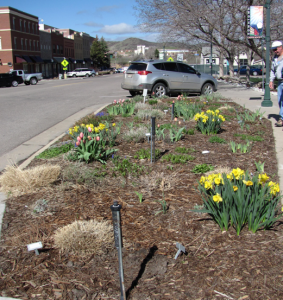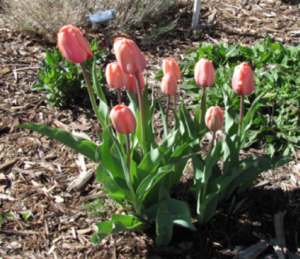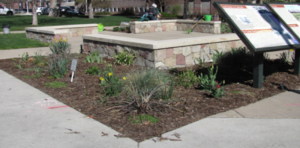
Through the Seasons at the Douglas County Public Gardens
The Douglas County Public Gardens are a point of pride for the Colorado Master Gardener program and the City of Castle Rock. Nestled among three Douglas County buildings in the heart of downtown Castle Rock are ten beds of annuals, perennials, ornamental grasses, and shrubs, many of which are from the Plant Select® progam.
Early May
Mid May
Late May and Early June
Mid June
Early May at Douglas County Public Gardens
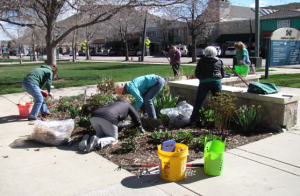
Early spring has found Douglas County CMG’s cleaning up the garden beds around the Douglas County Government Buildings. There are a variety of beds in the DC Public gardens, including xeric beds, many with native and Plant Select plants.
We will highlight plants that are blooming at this time with links to educational websites where you can find further information about gardening and various plant species.
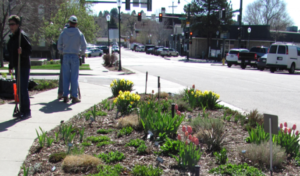
Xeric Bed #1 along 3rd Street
This bed was converted to a xeric bed two years ago.
Early spring shows promising growth of many plants with spring bulbs currently blooming. Are you interested in including spring flowering bulbs in your garden?

Xeric Bed #2 at the corner of Wilcox and 3rd Street
This bed was converted to a drought-tolerant garden during the summer of 2018.
Shade Garden Bed at DC Public Gardens
Plants in this bed compete with shrubs, trees and other perennials for moisture in dry soil and are therefore considered a dry shade bed. Plants require regular irrigation to develop a strong root system and will grow vigorously once established, especially the Brunnera species.

Garden Beds near Commissioners’ Building
This bed gets lots of shade during the morning hours. Springtime has found crocus, daffodils, and tulips blooming along with other spring flowering bulbs like a Striped squill.
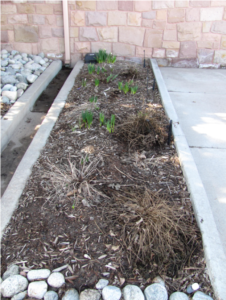

Back to top of page
Mid May at Douglas County Public Gardens
It has been a cool, wet spring at the DC Public Gardens and plants are slow to start growing. The main color in the gardens currently is from spring blooming bulbs, mainly tulips and daffodils.
Xeric Bed #1, #2, and #3
These beds are slow to start during the cool days and late snowfall the gardens have experienced this year. The red colors you see in these beds are from the many tulip bulbs planted during fall for spring blossoms. Erodium chrysanthum (Storksbill) is a plant with white flowers you will see in Spring and continue to bloom until frost.


Shade Garden Bed at DC Public Gardens
The main color in this garden amongst all the green is the pale blue from the still-blooming Brunnera macrophylia (False Forget-Me-Not or Siberian Bugloss)

Veteran’s Monument Bed
This bed starts to come alive in mid May. A highlight in this bed is the spring blooming Serviceberry Shrub. It is a very showy shrub with white blossoms in early to mid spring and is very hardy in the garden.
Consider the length of the growing season, soil characteristics and sun exposure before deciding what type of shrub or tree to plant. The fact sheet, Trees and Shrubs for Mountain Areas- 7.423, has general information and ideas for tree and shrub selection.

The common Periwinkle (Vinca minor ‘Bowles’) is a tough ground cover than can tolerate dry shade.

The Clock Tower Bed
This raised bed in the garden has just now started to show signs of plant life in mid-May. The first perennial to appear in spring is Plantain Lily (Hosta x ‘Fire & Ice’)
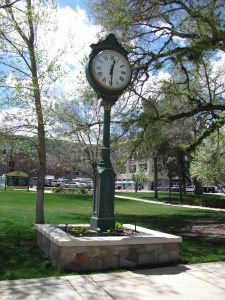
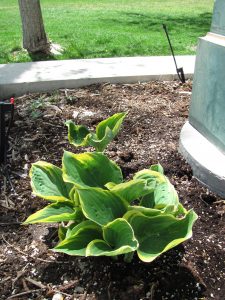
Back to top of page
Late May/ Early June at Douglas County Public Gardens
It is just past Memorial Day at the gardens and they are alive with color. The days are getting much longer and warmer and many of the plant species respond positively.

Xeric Bed #1
During late May this more established bed features color from many blooming perennial plants and fall planted iris tubers. In the picture below you will see Salvia nemerosa ‘Mainacht’ (Salvia ‘May Night’), as well as apricot and blue tall bearded Iris.

Xeric Bed #2
All the drought-tolerant beds at the DC Public Gardens include Plant Select® plants. These plants will have a special label to identify them as Plant Select®. Plant Select® is a cooperative effort among Colorado State University, the Denver Botanic Gardens, and the Colorado Green Industry that promotes plants that are able to thrive in the high plains and inter-mountain west.
Late May in Xeric Bed #2 sees the Plant Select® Hesperaloe parviflora (Red False Yucca) and Delosperma ‘P001S’ (Fire Spinner Ice Plant). Bearded Iris, Centranthus raber (Red Valerian), and Penstemon barbatus ‘Elfin Pink’ (Bearded Penstemon) complete the design.

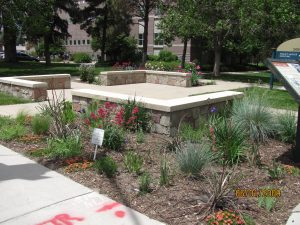
Shade Garden Bed at DC Public Gardens
This bed is lush and green as summer arrives. You will find a red shrub rose, yellow and blue columbines, and Penstemon digitalis ‘Husker’s Red’ (Husker Red Beardtongue) blooming in late May and early June.
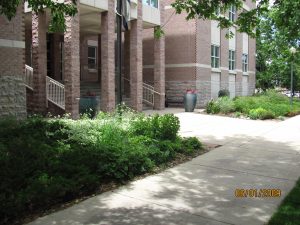
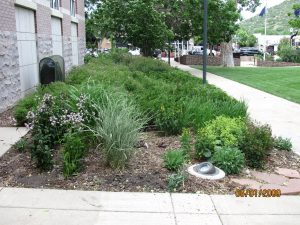
Veterans’ Monument Bed
The beautiful rose in this bed is the Winnipeg Parks Rose (Rosa x ‘Winnipeg Parks’). You will notice the apricot Iris x germanica is still in bloom and many Asiatic lilies are budding and will be blooming very soon.

Back to top of page
Mid-June at Douglas County Public Gardens
Xeric Bed #1
This xeric bed is starting to come alive with color now that nighttime temperatures are warming, along with the longer daylight hours. Plants blooming are Penstemon pinifolius (Pineleaf Penstemon), Salvia nemorosa (Salvia), Oenothera fremontii ‘Shimmer’ (Missouri Evening Primrose), Tanacetum densum ssp. amani (Partridge Feathers), Scrophularia macrantha (Red Birds-in-a-Tree), Penstemon barbatus (Bearded Penstemon) Salvia daghestanica (Platinum(R) Sage), and Echium amoenum (Red Feathers).

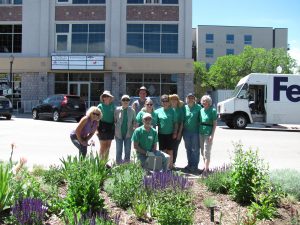
Veterans’ Monument Bed
The iris is finished blooming, but the shrub roses are beginning to show their true colors, as are the Asiatic lilies. This bed features Rosa foetida ‘Austrian Copper’ and Rosa x ‘Winnipeg Parks (Winnipeg Parks Rose). Roses can be grown in most Colorado communities. The CSU fact sheet on Selecting and Planting Roses can be a valuable resource for gardeners.

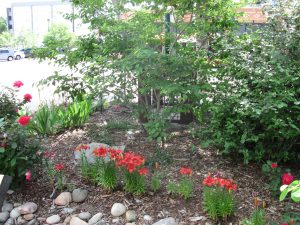
The Clock Tower Bed
The garden bed features several Plantain Lilies (Hosta x ‘Fire & Ice’), Astilbe x arendsii (hybrid false goat’s beard) and Lamprocapnos x ‘King of Hearts’ (fern-leaf bleeding heart). Derived from a North American native, this variety will stay at a manageable size at around 15 inches and blooms for much of summer.
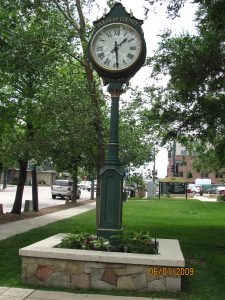

Back to top of page


